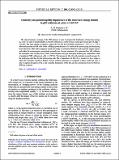Por favor, use este identificador para citar o enlazar a este item:
http://hdl.handle.net/10261/213044COMPARTIR / EXPORTAR:
 SHARE SHARE
 CORE
BASE CORE
BASE
|
|
| Visualizar otros formatos: MARC | Dublin Core | RDF | ORE | MODS | METS | DIDL | DATACITE | |

| Título: | Centrality and pseudorapidity dependence of the transverse energy density in p Pb collisions at √sNN = 5.02 TeV |
Autor: | Sirunyan, A. M.; Cabrillo, I. J. CSIC ORCID ; Calderon, Alicia ; Chazin Quero, B. CSIC; Duarte Campderros, J. CSIC ORCID ; Fernández-García, Marcos CSIC ORCID ; Fernández Manteca, P. J. CSIC ORCID; García Alonso, A. CSIC ORCID; García-Ferrero, J. CSIC ; Gómez, Gervasio CSIC ORCID ; López Virto, A. CSIC ORCID ; Marco, Jesús CSIC ORCID ; Martínez-Rivero, Celso CSIC ORCID ; Martínez Ruiz del Arbol, P. CSIC ORCID; Matorras, Francisco CSIC ORCID ; Piedra, Jonatan CSIC ORCID ; Prieels, C. CSIC; Rodrigo, Teresa CSIC ORCID ; Ruiz Jimeno, Alberto CSIC ORCID ; Scodellaro, Luca CSIC ORCID ; Trevisani, N. CSIC ORCID ; Vila, Iván CSIC ORCID; Vilar Cortabitarte, R. CSIC ORCID | Fecha de publicación: | 2019 | Editor: | American Physical Society | Citación: | Physical Review C 100(2): 024902 (2019) | Resumen: | The almost hermetic coverage of the CMS detector is used to measure the distribution of transverse energy, Eτ, over 13.2 units of pseudorapidity η for pPb collisions at a center-of-mass energy per nucleon pair of √sNN=5.02 TeV. The huge angular acceptance exploits the fact that the CASTOR calorimeter at -6.6 < η < -5.2 is effectively present on both sides of the colliding system because of a switch in the proton-going and lead-goingbeam directions. This wide acceptance enables the study of correlations between well-separated angular regionsand makes the measurement a particularly powerful test of event generators. For minimum biaspPb collisionsthe maximum value of dEτ/dη is 22 GeV, which implies an Eτ per participant nucleon pair comparable to thatof peripheral PbPb collisions at √sNN=2.76 TeV. The increase of dEτ/dη with centrality is much stronger forthe lead-going side than for the proton-going side. The η dependence of dEτ/dη is sensitive to the η range inwhich the centrality variable is defined. Several modern generators are compared to these results but none isable to capture all aspects of the η and centrality dependence of the data and the correlations observed between different η regions. | Descripción: | CMS Collaboration. | Versión del editor: | https://doi.org/10.1103/PhysRevC.100.024902 | URI: | http://hdl.handle.net/10261/213044 | DOI: | 10.1103/PhysRevC.100.024902 | Identificadores: | doi: 10.1103/PhysRevC.100.024902 e-issn: 2469-9993 issn: 2469-9985 |
| Aparece en las colecciones: | (IFCA) Artículos |
Ficheros en este ítem:
| Fichero | Descripción | Tamaño | Formato | |
|---|---|---|---|---|
| centralTeV.pdf | 1,26 MB | Adobe PDF |  Visualizar/Abrir |
CORE Recommender
SCOPUSTM
Citations
9
checked on 11-abr-2024
WEB OF SCIENCETM
Citations
3
checked on 22-feb-2024
Page view(s)
268
checked on 17-abr-2024
Download(s)
84
checked on 17-abr-2024
Google ScholarTM
Check
Altmetric
Altmetric
NOTA: Los ítems de Digital.CSIC están protegidos por copyright, con todos los derechos reservados, a menos que se indique lo contrario.
